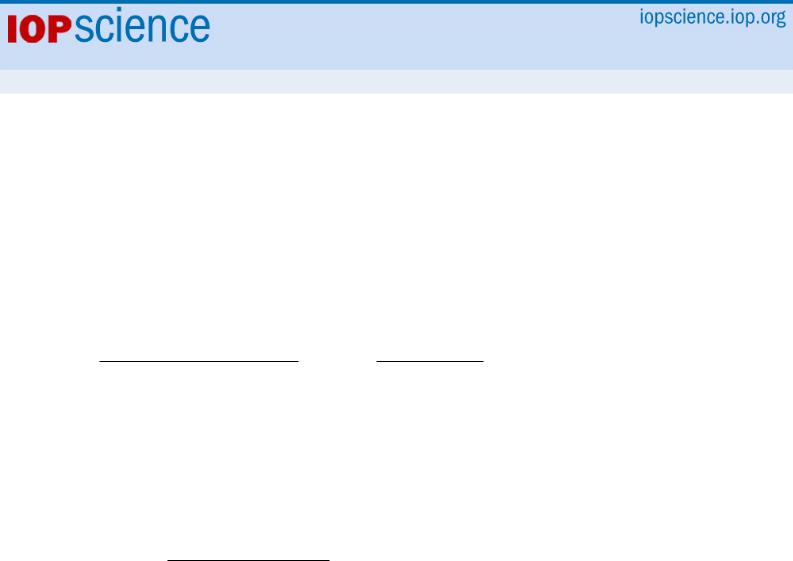

Home Search Collections Journals About Contact us My IOPscience
Complex magnetic interactions in off-stoichiometric NiMnGa alloys
This article has been downloaded from IOPscience. Please scroll down to see the full text article.
2010 J. Phys.: Condens. Matter 22 346001
(http://iopscience.iop.org/0953-8984/22/34/346001)
View the table of contents for this issue, or go to the journal homepage for more
Download details:
IP Address: 130.34.64.49
The article was downloaded on 24/08/2010 at 12:25
Please note that terms and conditions apply.

IOP PUBLISHING |
JOURNAL OF PHYSICS: CONDENSED MATTER |
J. Phys.: Condens. Matter 22 (2010) 346001 (6pp) |
doi:10.1088/0953-8984/22/34/346001 |
Complex magnetic interactions in off-stoichiometric NiMnGa alloys
Subhradip Ghosh1 and Biplab Sanyal2,3
1Department of Physics, Indian Institute of Technology Guwahati, Guwahati-781039, India
2Division of Materials Theory, Department of Physics and Astronomy, Uppsala University, Box-516, 75120 Uppsala, Sweden
E-mail: Biplab.Sanyal@fysik.uu.se
Received 25 May 2010, in final form 3 July 2010
Published 2 August 2010
Online at stacks.iop.org/JPhysCM/22/346001
Abstract
Using first-principles density functional theory, the magnetic pair interactions between various pairs of chemical specie have been calculated and the trends in magnetism with varying compositions and chemical ordering are analyzed for three off-stoichiometric NiMnGa alloys in their austenite phases. The experimentally observed trend of decreasing magnetization with increasing Mn concentration is attributed to the antiferromagnetic interactions among Mn atoms occupying sublattices other than the original Mn one. The role of chemical ordering on magnetization is also analyzed by total energy results and exchange interactions. We are able to explain the recently published neutron scattering experiments with our theoretical analyses.
(Some figures in this article are in colour only in the electronic version)
1. Introduction
Ferromagnetic Heusler alloy Ni2MnGa exhibits the shape memory effect and recoverable magnetic field induced strain. These materials are quite promising as high sensitivity magnetic sensors and actuators. The structural transformations, magnetic properties and the interplay of these two effects have been widely investigated for the Ni2MnGa system at stoichiometric composition [1–4]. However, from the point of view of practical applications the alloy with stoichiometric composition of 50:25:25 has severe limitations. The thermoelastic martensitic transformation temperature of the stoichiometric alloy being 200 K makes it unfavorable for application at room temperature. A high saturation magnetization is also desirable for the alloy to establish a large magnetic field induced strain. In order to circumvent
these limitations, the |
introduction of |
chemical |
disorder |
in |
a controlled manner |
is a necessity. |
This is |
due to |
the |
fact that a small degree of chemical disorder can introduce defects of a structural and magnetic nature that may alter the characteristic temperatures associated with the martensitic and magnetic transformation, the net magnetic moment and/or affect the output strain. These intuitions are substantiated by recent experiments in which it was observed that the highest
3 Author to whom any correspondence should be addressed.
known magnetic field induced strain of 10% is achieved for Ni1.95Mn1.19Ga0.86 at ambient temperature in a magnetic field of 1 T [5, 6] and that the martensitic transformation temperature can be increased beyond room temperature for Ni2.15Mn0.85Ga [7].
In order to facilitate the technological breakthrough, a detailed understanding of the magnetic interactions and the nature of chemical ordering in different sublattices of the disordered samples is necessary. This is more so in the light of the unexpected trends in total magnetization of Mnrich alloys. In the stoichiometric sample, the saturation magnetization of 4.1 μB has contributions of about 3.5 μB from the Mn sublattice; therefore it was expected that the saturation magnetization will increase on increasing the Mn concentration. In recent magnetization measurements of various Mn-excess samples [8], an opposite trend has been observed. From these counter-intuitive results, it was inferred that the excess Mn atoms occupying sublattices other than the Mn ones are coupled antiferromagnetically with respect to the ones occupying the original Mn sublattice, thereby reducing the net magnetization upon increasing Mn content. This was further confirmed by total energy calculations [8] on the Ni2Mn1.25Ga0.75 system where the existence of both ferromagnetic and antiferromagnetic alignments of Mn atoms was observed and the calculated energies of the antiferromagnetic configuration
0953-8984/10/346001+06$30.00 |
1 |
© 2010 IOP Publishing Ltd Printed in the UK & the USA |
